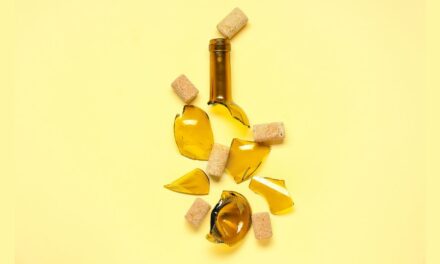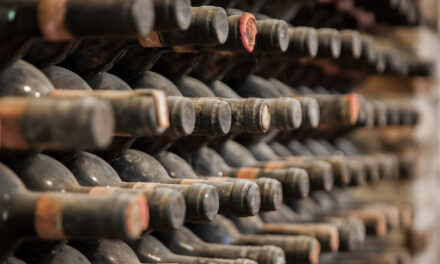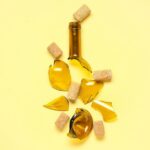When it comes to wine, beauty is in the eye of the beholder. What can be an intriguing, beautiful aroma to one person might nauseate the next. Wine is undeniably subjective, which makes sticky business out of identifying a wine as flawed.
There are several undeniable wine faults out there, including TCA (“corkiness”), heat damage, and light strike– but there are just as many (if not more) moderate wine faults that some wine drinkers love. So let’s cover the most widely disputed faults in the wine world. We will dive into the science behind these moderate wine faults, how to identify them, and when they should actually be considered flaws.
Oxidation
If your wine has gone stale it may be the effects of oxidation. If your wine tastes toasty, nutty, earthy, or even apple-y? Well… that’s also oxidation!
What Causes Oxidation
Oxidation is a chemical reaction caused when oxygen comes into contact with the alcohol in the wine, causing it to convert to acetaldehyde. The acetaldehyde compound is a naturally occuring, and can be found in fruit, vegetables, vinegar, dairy products, and of course, wine.
Oxidation starts to occur before a wine is even opened, especially bottles closed with a natural cork. This is how wine “ages” in the bottle– through small amounts of controlled oxidation over time.
The oxidation process occurs at double-time as soon as a wine is opened. An opened bottle can oxidize in as little as two days, and will eventually turn into vinegar. But exposure to oxygen is not a death sentence for wine, in fact, it’s part of what makes certain wines so delicious! For this very reason we pour our wine into glasses that allow us to swish and swirl the vino into oxidized deliciousness.
Slow, micro oxidation is the key to proper in-bottle aging. Big, bold reds like Bordeaux blends develop their deep, earthy notes through oxidation in the winemaking process and through exposure to small amounts of oxygen that seep through the cork over time. Wines will also be intentionally oxidized through aeration and decanting, a particularly important step in mellowing young or high-tannin wines. Sometimes oxidation is part of the winemaking process, as with certain ports and sherries.
Oxidation only becomes a fault once the alcohol has been converted to acetaldehyde, disrupting the wine’s flavors, aromas, and hue.
How to Identify Oxidation
Oxidation can first be identified visually. An oxidized wine will lose its vibrancy in color– reds will appear a tawny, brownish-orange in the glass, and oxidized whites will appear a deep and dull gold or even brown. Over-the-hill wines will taste sour, with notes of metal and apple cider vinegar.
Can You Fix It?
Technically, an oxidized wine can be fixed by incorporating skim milk to the wine, but we wouldn’t recommend drinking a wine/milk cocktail. It can be a total bummer (especially if you accidentally overshot the cellaring process!), but if your wine is over-the-hill, we recommend taking the L and uncorking the next. Oxidized bottles can still be incorporated into your meal as a cooking wine!
How to Prevent Oxidation
The best way to prevent oxidation is to practice proper wine storage. Storing your wine on its side will keep the cork moist. Ensuring your cork does not dry out is crucial– dry, crumbly corks let air seep into the bottle, speeding up its oxidation.
Once you open a bottle, the oxidation process begins, but there are ways that you can slow it down. The easiest of which is to keep your opened wine bottles in the fridge; cooler temperatures slow down chemical processes. A refrigerator won’t keep your wine fresh indefinitely, but it could buy you an extra day or three of drinkability. We recommend finishing your bottle as soon as you can, and tossing it after it has reached five days in the fridge.
That’s not a lot of time to finish a bottle, but don’t worry, the wine gadget market has taken note of this common issue and responded with a techy-solution. If you want to keep your bottle fresh for as long as possible, a gas-saving system might be a sound investment. We use the Coravin here at First Bottle HQ. These systems limit the oxidation process by filling the wine bottle with argon gas through a cork-piercing needle.
Here’s how it works: Instead of removing the cork from your bottle, you’ll attach the dispenser nozzle. A surgical needle (literally; their founder is a medical engineer) allows enough space for wine to flow out, but does not permanently damage the resilient plant material of the cork. As the wine is poured, the Coravin pumps in argon gas to fill in the empty space, keeping oxygen out. Even if oxygen were to make its way into the bottle, the heavier argon will settle over the surface of the vino like a shield. Once you’re done, you can remove the nozzle, and viola – fresh wine… for about three weeks!
Brettanomyces
Brettanomyces is the center of much debate in the wine world. Otherwise known as brett or brettiness, this is the yeast that nobody can agree upon.
What Causes Brettanomyces
Brett is a wild yeast that grows naturally on fruit skins. This genus of yeast can be carried into the winery from the fruit itself, or by fruit flies. And once brett is in, it can hang out in barrels and in a winery’s equipment, dosing vintage after vintage with its signature flavor and aromatics.
Much like Saccharomyces, the yeast responsible for alcoholic fermentation in wine, brettanomyces consumes sugars and converts it into alcohol and CO2, as well as several other compounds that influence natural aromas, flavors, and textures. While Saccharomyces’ effect on wine is essential to the winemaking process, brettanomyces’ effect tends to split the aisle in the wine world.
Saccharomyces and brettanomyces also differ in their growth patterns. Saccharomyces consume glucose and fructose within the grape-must at a rapid pace, only stopping when the sugars have run out or when the alcohol level gets too high. Brettanomyces, however, works slowly, consuming not only glucose and fructose, but a wine’s unfermentable complex sugars as well as oak sugars. Brett’s slow and steady pace can render it undetectable in the early stages of the winemaking process.
In many cases, brett may not present itself until after a wine has undergone barrel aging. Previously-used oak barrels are a leading culprit of brett infection, but even new oak barrels (especially toasted ones) can provide enough sugar for brett to thrive. Brett can thrive in any vineyard or cellar, but because it’s a naturally occurring nuance, it is sometimes regarded as an element of terroir or a factor in a winery’s signature style.
How to Identify Brettanomyces
Brett expresses itself in a wide range of aromas. The “good” brett expressions include: clove, bacon, leather, spice, smoke, earth. The “bad” include: horse stable, barnyard, Band-Aid, manure, antiseptic, and sewage.
The good brett aromas are caused by 4-Ethylguaiacol, or 4-EG, a compound produced when brett interacts with polyphenols (the compound that brings you tannic acid) found in grape skins. The “bad” are a result of 4-Ethylguaiacol, or 4-EP, which is also formed by the interaction of brettanomyces and polyphenols. It is estimated that most people will identify a wine as “brett-like” when the 4-EG level reaches 300 micrograms per liter, and when the horsey 4-EP reaches only 50 micrograms per liter. Though volatile brett certainly exists, the more pleasant 4-EG is much more prevalent than the offensive 4-EP.
“Brettiness” is much more common in red wines, both because red wines are more abundant in polyphenols and because red wines spend more time aging in oak barrels. However, tasters are much less likely to identify a red wine as bretty because aromas of clove, spice, earth, and leather are typical nuances in many red wines.
Brett spoilage, however, is much easier to discern in white and sparkling wines (and significantly more often agreed upon as spoilage in the wine world.) The delicate aromas of a white wine are easily disturbed by the powerful aromas of both 4-EG and 4-EP. White wines are more exposed to brett when they are not treated with SO2, making natural white wines a common target for this yeast to thrive.
As you’re tasting brett across every style of wine, take note of the bretty-expressions you like to the extent that you like them. Those spicy, savory, smokey nuances may make you a staunch brett-lover, and barnyard notes might be right up your alley! (We won’t yuck your yum, get down with your bad self!)
Can You Fix It?
The more appropriate question here is, does it need to be fixed? For many (including a very loud contingent of brett-devotees here at First Bottle HQ), the answer is no, but it all comes down to your personal preferences. Brett can be remedied at the winery with sterile filtration, and kept under control with effective sulfur management. However, if you suspect a bottle you cracked at home has some brett spoilage, there’s nothing you can do to neutralize the yeast’s expressions besides learn how to appreciate the savory/ spicy/ musky/ horsey/ barnyard notes wafting from your extra-yeasty wine. Or… dine with a buddy who can.
Volatile Acidity
Ever had a wine that tastes like it was mixed with a splash of vinegar? Chances are, that’s volatile acidity doing its thang. Volatile acidity is another hotly debated topic amongst wine people: some folks appreciate it, others see it only as spoilage.
What Causes Volatile Acidity
Volatile acidity refers to the levels of a wine’s gaseous acids, particularly acetic acid, the primary acid behind the aromas of vinegar and ethyl acetate, which emits an aroma reminiscent of nail polish remover.
All wines have a certain level of VA. In fact, VA levels in domestic wine are regulated by the Federal Tax & Trade Bureau. They determine appropriate levels of VA based on style and region, and they vary. For instance, a California white wine’s legal VA limit is 1.1 gram per liter, and an Oregon white wine’s limit is set at 1.5 gram per liter.
VA levels will rise in the winemaking process. Everytime a wine is racked (moved from one receptacle to another) it is exposed to more and more oxygen and bacteria. Some of this bacteria in the air, such as Acetobacter and Gluconobacter, cause VA to form– meaning that increased exposure to oxygen in the winemaking process can lead to a greater risk of VA.
In small amounts, VA can be favorable. Some wines need that touch of VA– but when a wine is overpowered with VA, it is considered spoilage.
Although volatile acidity is most commonly associated with the aroma of vinegar, most people cannot smell VA until the problem has become severe, despite the fact that the smell of vinegar is so distinct. Acetic acid can remain undetectable to the nose up to three grams per liter, whereas ethyl acetate can be detected at levels between 100 and 120 milligrams per liter. Because acetic acid can be pretty sneaky (and because its presence may not pose an issue at all) winemakers and wine drinkers see ethyl acetate as the primary sensory indicator of a wine’s volatile acidity.
How to Identify Volatile Acidity
Start by smelling the wine; if it exhibits strong, overpowering vinegar or nail polish remover aromas, it may be a sign of volatile acidity. These aromas will present themselves on the palate as sharp, acrid, or overly acidic, which will overwhelm the fruitiness of the wine.
Can You Fix It?
Winemakers have a few options to remedy high levels of VA, including oak aging, masking with sweetness, blending, or removing it entirely with reverse osmosis or nanofiltration. However, once a bottle tainted with large amounts of VA hits your cellar, there’s not much you can do about it.
Reduction
Oxygen is as important to fine wine as it is to humans. Reduction is what happens when your wine can’t “breathe.”
What Causes Reduction
Reduction is a complex and undesirable phenomenon that occurs when certain chemical reactions, often involving sulfur compounds, take place in the absence of oxygen. This process can result in off-putting odors and flavors in the wine.
Reduction is primarily driven by the presence of sulfur-based compounds, such as hydrogen sulfide, mercaptans, and disulfides. These compounds can form during the fermentation and aging process when yeast or bacteria interact with sulfur-containing compounds in the absence of oxygen. Some yeast strains and lactic acid bacteria used in winemaking can produce sulfur compounds as metabolic byproducts. In certain situations, excess SO2 can interact with other sulfur compounds, leading to the formation of undesirable reductive aromas.
How to Identify Reduction
Reduction in wine often produces off-putting odors reminiscent of burnt rubber, sulfur, garlic, skunk, matches, sewage, or rotten eggs due to the presence of hydrogen sulfide gas. Another key indicator is a lack of fruitiness and a muted flavor profile. Reduced wines can taste flat, with an overall lack of vibrancy.
Can You Fix It?
If you’re catching some slight reduction on your glass, some of those unfavorable notes can be fixed with aeration. Your wine was lacking oxygen, so give it some CPR! Bring out your decanter or swirl your glass to revive your vino.
Still catching reductive notes? Drop a clean penny in your decanter and swirl. The reductive properties in the wine will react with the copper in the penny, and release the odorless copper sulfide, which will resolve the reductive aromas.
In Conclusion
Though oxidation, brett, volatile acidity, and reduction are listed as wine faults, their presence does not inherently render the wine as flawed. These compounds are divisive, no doubt, but these compounds are as capable of intrigue as they are repulsion.
These phenomena are only considered faults when they are severe enough to turn you away from the wine. What is a flawed wine to one person’s palate may be perfectly acceptable to yours. Don’t let anyone knock you down for digging these complex (and controversial) aromas and flavors! Own your palate and its ability to dig into wine nuances even some connoisseurs can’t get down with.
The best way to discover your fault line is to taste more wine. And lucky for you, you’re in the right place! Start refining your palate with our wide selection of premium wines.












